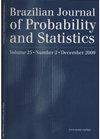在潜在空间中定位社会网络群体的另一类模型
IF 0.5
4区 数学
Q4 STATISTICS & PROBABILITY
引用次数: 0
摘要
识别关键节点、估计它们之间连接的概率以及区分潜在群体是社交网络分析的一些主要目标。在本文中,我们提出了一类块模型来建模不可观测空间中的随机等价和可视化群。在这种情况下,所提出的方法基于两种方法:潜在距离和群体层面的潜在相异性。与文献中的主要方法不同,本文中提出的投影是在不需要投影个人的情况下进行的。我们的方法可以用于无向图或有向图,并且足够灵活,可以对社交网络中的组间和组内平局概率进行聚类和量化。在人工数据集和两个案例研究中分析了该方法在潜在空间中代表群体的有效性。本文章由计算机程序翻译,如有差异,请以英文原文为准。
An alternative class of models to position social network groups in latent spaces
Identifying key nodes, estimating the probability of connection between them, and distinguishing latent groups are some of the main objectives of social network analysis. In this paper, we propose a class of blockmodels to model stochastic equivalence and visualize groups in an unobservable space. In this setting, the proposed method is based on two approaches: latent distances and latent dissimilarities at the group level. The projection proposed in the paper is performed without needing to project individuals, unlike the main approaches in the literature. Our approach can be used in undirected or directed graphs and is flexible enough to cluster and quantify between and within-group tie probabilities in social networks. The effectiveness of the methodology in representing groups in latent spaces was analyzed under artificial datasets and in two case studies.
求助全文
通过发布文献求助,成功后即可免费获取论文全文。
去求助
来源期刊

Brazilian Journal of Probability and Statistics
STATISTICS & PROBABILITY-
CiteScore
1.60
自引率
10.00%
发文量
30
审稿时长
>12 weeks
期刊介绍:
The Brazilian Journal of Probability and Statistics aims to publish high quality research papers in applied probability, applied statistics, computational statistics, mathematical statistics, probability theory and stochastic processes.
More specifically, the following types of contributions will be considered:
(i) Original articles dealing with methodological developments, comparison of competing techniques or their computational aspects.
(ii) Original articles developing theoretical results.
(iii) Articles that contain novel applications of existing methodologies to practical problems. For these papers the focus is in the importance and originality of the applied problem, as well as, applications of the best available methodologies to solve it.
(iv) Survey articles containing a thorough coverage of topics of broad interest to probability and statistics. The journal will occasionally publish book reviews, invited papers and essays on the teaching of statistics.
 求助内容:
求助内容: 应助结果提醒方式:
应助结果提醒方式:


